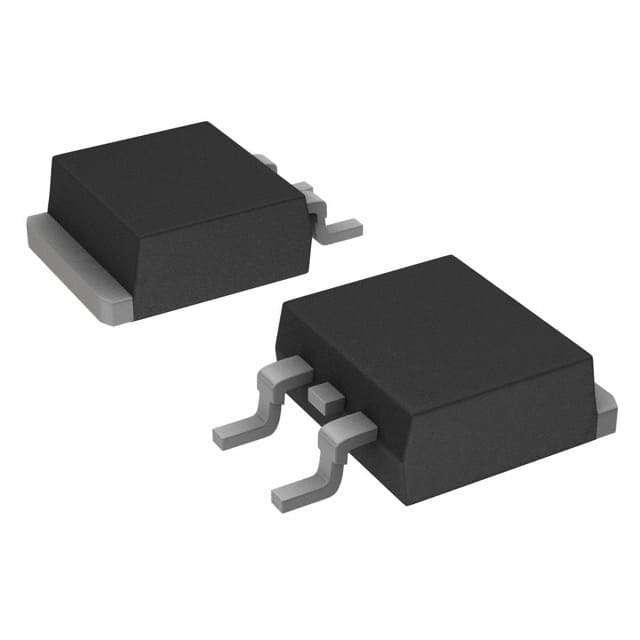SBLB10L25HE3/45: Product Overview and Specifications
Introduction
The SBLB10L25HE3/45 is a high-efficiency, low-profile Schottky rectifier designed for use in various electronic applications. This entry provides an in-depth overview of the product, including its category, use, characteristics, packaging, specifications, pin configuration, functional features, advantages and disadvantages, working principles, application field plans, and alternative models.
Basic Information Overview
- Category: Electronic Components
- Use: Rectification in power supply circuits, voltage clamping, and freewheeling diode applications
- Characteristics: High efficiency, low forward voltage drop, fast switching, and low thermal resistance
- Package: TO-263AB (D2PAK)
- Essence: Schottky rectifier with superior performance
- Packaging/Quantity: Tape and reel packaging, quantity per reel varies based on customer requirements
Specifications
- Part Number: SBLB10L25HE3/45
- Maximum Average Forward Current: 10A
- Peak Forward Surge Current: 150A
- Reverse Voltage: 25V
- Forward Voltage Drop: 0.55V at 5A
- Operating Temperature Range: -65°C to +175°C
- Storage Temperature Range: -65°C to +175°C
Detailed Pin Configuration
The SBLB10L25HE3/45 follows the standard pin configuration for the TO-263AB package: 1. Pin 1: Anode 2. Pin 2: Cathode 3. Pin 3: Anode
Functional Features
- High efficiency and low power loss
- Fast switching speed for improved circuit response
- Low forward voltage drop leading to reduced conduction losses
- Excellent thermal management due to low thermal resistance
Advantages and Disadvantages
Advantages
- Superior efficiency compared to traditional rectifiers
- Reduced heat generation due to low forward voltage drop
- Compact form factor and low profile design
Disadvantages
- Higher cost compared to standard rectifiers
- Limited reverse voltage capability compared to some alternatives
Working Principles
The SBLB10L25HE3/45 operates based on the Schottky barrier principle, where the metal-semiconductor junction allows for faster switching and lower forward voltage drop compared to conventional PN-junction diodes. When forward biased, the rectifier conducts current with minimal voltage drop, making it suitable for high-frequency applications and power supply circuits.
Detailed Application Field Plans
The SBLB10L25HE3/45 finds extensive use in the following application fields: - Switching power supplies - Voltage clamping circuits - Freewheeling diode applications in motor drives - Solar inverters and power conditioning systems
Detailed and Complete Alternative Models
For users seeking alternative models with similar characteristics, the following options are available: 1. SBLB20L30HE3/45: 20A, 30V Schottky rectifier 2. SBLB15L20HE3/45: 15A, 20V Schottky rectifier 3. SBLB12L18HE3/45: 12A, 18V Schottky rectifier
In conclusion, the SBLB10L25HE3/45 offers high efficiency, fast switching, and low forward voltage drop, making it an ideal choice for various electronic applications requiring reliable rectification and low power loss.
Word Count: 488
Senaraikan 10 soalan dan jawapan biasa yang berkaitan dengan aplikasi SBLB10L25HE3/45 dalam penyelesaian teknikal
What is the SBLB10L25HE3/45?
- The SBLB10L25HE3/45 is a Schottky barrier rectifier diode designed for high efficiency and low power loss applications.
What is the maximum forward voltage of the SBLB10L25HE3/45?
- The maximum forward voltage of the SBLB10L25HE3/45 is typically 0.55V at 5A.
What is the maximum reverse voltage of the SBLB10L25HE3/45?
- The maximum reverse voltage of the SBLB10L25HE3/45 is 25V.
What are the typical applications of the SBLB10L25HE3/45?
- The SBLB10L25HE3/45 is commonly used in power supplies, LED lighting, and other low voltage, high efficiency applications.
What is the operating temperature range of the SBLB10L25HE3/45?
- The SBLB10L25HE3/45 has an operating temperature range of -65°C to +150°C.
What is the package type of the SBLB10L25HE3/45?
- The SBLB10L25HE3/45 comes in a DPAK (TO-252) package.
Is the SBLB10L25HE3/45 RoHS compliant?
- Yes, the SBLB10L25HE3/45 is RoHS compliant.
What are the key features of the SBLB10L25HE3/45?
- The key features include low forward voltage drop, high current capability, and high surge capability.
What are the recommended storage conditions for the SBLB10L25HE3/45?
- It is recommended to store the SBLB10L25HE3/45 in a dry environment with a temperature range of -55°C to +150°C.
What are the typical performance characteristics of the SBLB10L25HE3/45 in comparison to similar diodes?
- The SBLB10L25HE3/45 offers lower forward voltage drop and higher efficiency compared to similar diodes, making it suitable for energy-efficient designs.


